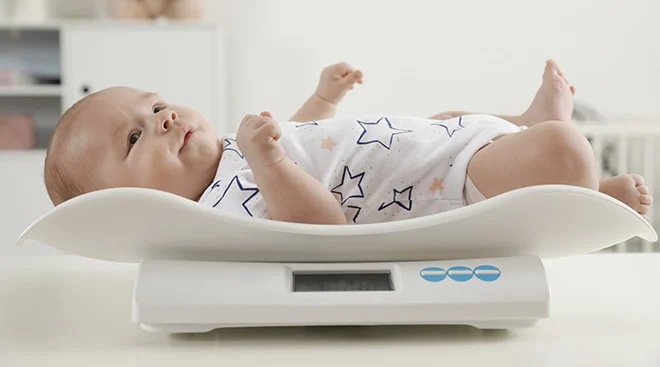
It can be challenging to ascertain if your infant is on a healthy trajectory in terms of stature and mass, given the diversity of sizes and shapes among toddlers.
If your child appears to be either taller or shorter than other kids their age, it’s natural to be concerned. We experienced this firsthand with our oldest son being of greater stature and our youngest son considerably smaller. If we’d had the knowledge then that we now have concerning the height and weight percentiles among toddlers, there would have been significantly less worrying.
We’ll spare you the agitating all-nighters and superfluous medical clinic trips we experienced. Here’s our parent-to-parent manual for toddler development, the graphs, and when you should take them to the physician.
Contents
Typical toddler weights and heights
The typical weight and height of a toddler vary depending on their age. Generally, toddlers growth standards between the ages of one and two weigh around 22 to 30 pounds, and are about 27 to 35 inches tall. As a child is growing older, they will typically gain about 4-5 pounds each year and grow 2 to 3 inches each year until they reach puberty.
It’s important for parents to monitor their child’s growth, as it can be an indicator of their overall health. Regular check-ups with a doctor will help ensure that your toddler is growing at a healthy rate. Additionally, good nutrition and plenty of physical activity are great ways to make sure your little one stays healthy and continues to grow in the right direction.
Toddler Growth Chart
The toddler growth chart is an excellent tool for tracking the physical and cognitive development of young children. It charts a child’s height and weight, as well as other factors such as head circumference, fine and gross motor skills, language development, social-emotional development, and vision and hearing.
This chart can help parents compare their child’s progress to that of other children their age. It also serves as a helpful guide for healthcare providers to identify any potential delays or issues with a child’s development that may need to be addressed. The toddler growth chart is an invaluable tool for monitoring the health and well-being of young children.
What factors can affect my child’s weight and height?
There are a variety of factors that can affect a child’s birth weight and also height. Genetics is one of the most important, as it determines a large portion of the range within which a child’s growth will fall. Nutrition is also important; Breastfed and formula-fed infants develop in slightly varied ways. children need to consume enough calories, proteins, vitamins, and minerals in order to grow properly.
Exercise can help increase muscle mass and bone density, while lack of exercise can lead to slower growth. Health conditions such as chronic illnesses or infections can also have an effect on a child’s growth rate.
Lastly, environmental factors such as access to clean water and sanitation can make a difference in how quickly or slowly a child grows. By understanding these various factors and providing your child with the best possible care, you can ensure they have every opportunity to reach their full potential in terms of both height and weight.
What Do Growth Chart Percentiles Mean?
Growth chart percentiles are a way to compare your child’s growth and development to that of other children their age. They measure height, weight, head circumference, and other data points. The percentile is calculated by comparing your child’s measurement to the measurements of a large group of children who are the same age and sex. For example, if your child is in the 50th percentile for height, it means that half of all children the same age and gender are taller than your child and half are shorter than your child.
Percentiles can be used as a general guide, but should not be used as an absolute indicator of health or growth status since many factors can affect a child’s growth. It is important to discuss any concerns with your child’s pediatrician and stay up-to-date on their regular checkups so that any potential issues can be identified and addressed in a timely manner.
When Should You Be Worried About Your Child’s Weight?
When it comes to your child’s weight, it is important to observe any changes in your child’s body closely. If your child’s BMI (body mass index) falls below the fifth percentile or rises above the 95th percentile for their age and gender, you should be concerned about your child’s weight. Additionally, if you notice that your child is losing too much weight or gaining too much weight quickly, you should consult with a doctor right away.
Poor eating habits, extreme dieting, and a lack of physical activity can all contribute to unhealthy weight gain or loss in children. If you are worried that your child may have an eating disorder such as anorexia nervosa, bulimia nervosa, or binge eating disorder, it is important to speak with a healthcare professional right away. Taking action now can help ensure that your child will stay healthy and happy over time.
What If My Toddler Is Bigger or Smaller?
If your toddler is bigger or smaller than average, there’s no need to worry. It’s perfectly normal for children to be different sizes and shapes. However, you should monitor their growth patterns and consult a doctor if there are any major changes. Your child may only be going through a growth spurt or experiencing delayed growth, so it’s important to keep an eye on them.
If your toddler is bigger than average, ensure they get plenty of physical activity and that their nutrition is balanced. If they are smaller than average, make sure they’re eating nutritious meals that provide enough calories for healthy growth and development. By monitoring your child’s growth and following the advice of a doctor, you can ensure that your child grows up healthy and strong.
What Strategies Can I Use to Help My Toddler Lose Weight?
When it comes to helping a toddler lose weight, there are several strategies that can be applied. The most important step is to create a healthy lifestyle for the child. This includes eating nutritious meals and snacks, limiting sugary drinks and processed foods, and being physically active every day.
Additionally, parents should create an environment that encourages healthy eating habits. This means no skipping meals or snacks, allowing plenty of time for physical activity, and setting clear boundaries around unhealthy food choices.
Finally, it’s important to establish a consistent schedule for eating and sleeping so that your toddler has the energy they need to stay active throughout the day. With these strategies in place, you can help your toddler reach a healthier weight in no time.
What should a healthy 2-year-old weigh?
A healthy 2-year-old should weigh between 22 and 32 pounds. This range varies depending on the child’s gender, height and developmental level. Generally, boys tend to weigh slightly more than girls at this age. Additionally, a child with a higher body mass index (BMI) may be considered healthy if they are growing steadily.
It is important to remember that every child develops differently and that their weight range may not fall within the average range. If you have any concerns about your 2-year-old’s weight or development, it is best to consult your pediatrician for advice.
How much should a 3-year-old weigh?
According to CDC (US Centers for Disease Control and Prevention), The average weight for a 3-year-old child is between 30.7 for girls and 31.8 pounds for boys. Generally, girls tend to weigh less than boys, but this can vary depending on the individual’s size and body type. It’s important to note that children develop differently, so there is no one weight that is right or wrong for a 3-year-old.
The CDC advises following the World Health Organization (WHO) charts during the initial two years of a child’s life (ages 0 to 2). However, if your child falls outside of this range or you are concerned about their health, it’s best to speak with your pediatrician who can assess your child’s growth and development.
Your pediatrician can also offer advice on how to help maintain a healthy weight. Regular physical activity and consuming a balanced diet of nutritious foods high in vitamins and minerals will help support your child’s healthy growth and development.
How much weight should a child gain between 4 and 5 years?
A child between the ages of 4 and 5 years should gain an average of around 6-7 pounds in a year. Additionally, it is recommended for them to grow about 2-3 inches during this period. Children grow at different rates that vary from one child to another, so it’s important to keep track of your child’s progress in terms of weight and height.
It is also recommended that children follow a healthy diet and get ample exercise during this time in order to ensure they are getting the necessary nutrients and growing at a healthy rate. Furthermore, if you notice your child has not gained any weight or grown much in height since their last checkup, it may be wise to consult with their doctor as this could be a sign of health issues or growth delays.
Do Not Be Anxious Regarding Your Little One’s Weight
Do not be anxious regarding your little one’s weight. It is important to remember that a healthy weight is a journey, not a destination. Children’s diets and activity habits are constantly changing and developing as they grow. Taking the time to focus on balanced nutrition, regular physical activity, and overall well-being can help children reach their full potential.
Encourage your child to eat nutritious foods and limit processed foods that are high in sugar, salt, and unhealthy fats. Make sure they get plenty of exercises, including playing outside or joining an organized sport. Talk to your doctor if you have any concerns about your child’s health or weight gain so that you can make sure your child is healthy and meeting their nutritional needs. With patience, understanding, support, and guidance from parents and caregivers, children can develop lifelong healthy habits for a happy and healthy life.

![What Parents Need to Know About Coronavirus [Simple Guide]](https://allmomneeds.com/wp-content/uploads/2020/03/What-Parents-Need-to-Know-About-Coronavirus-Simple-Guide-1.jpg)

